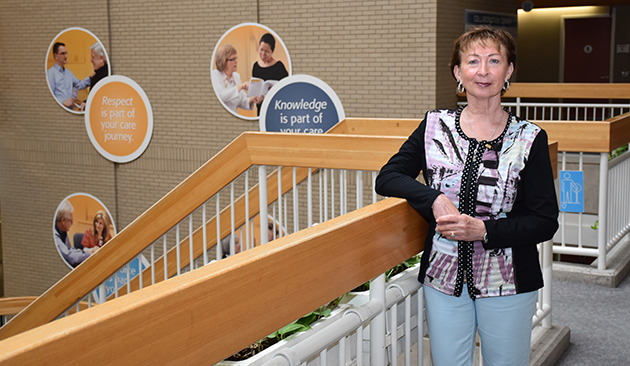

For Betty Ostrander, an operating room nurse from Tillsonburg, Ontario, a throat cancer diagnosis was life-changing.
Betty was 59 years old when she discovered a small lump on the right side of her neck while walking her dogs in Florida. Thinking that she might be coming down with a cold, she waited a couple of days but the lump was still there.
“I went to a walk-in clinic in Florida and the nurse told me I was healthy,” says Betty. “She prescribed me antibiotics but I asked her for an ultrasound requisition.”

Above: Betty Ostrander, Research Participant in the ORATOR clinical trial
Betty’s ultrasound showed two enlarged lymph nodes. A surgical colleague suggested she go see an otolaryngologist (ear, nose and throat (ENT) doctor). After further medical testing in the US and in Canada, she was told she had oropharyngeal cancer (cancer at the back of the throat) and was referred to Dr. Anthony Nichols, Associate Scientist at Lawson Health Research Institute and Head and Neck Cancer Surgeon at London Health Sciences Centre (LHSC).
“I remember thinking ‘I’m healthy, I eat right and I exercise; this can’t be happening to me.’ But it was, and it was scary,” recalls Betty. “After some online research, one of the first questions I asked Dr. Nichols was whether there were any clinical trials available and he told me I was in luck.”
In 2012, Dr. Nichols and his colleague Dr. David Palma, Associate Scientist at Lawson and Radiation Oncologist at LHSC, launched the world’s first clinical trial comparing robotic surgery to radiation therapy for the treatment of oropharyngeal cancer. Funded by the Canadian Cancer Society, the goal was to compare quality of life, particularly swallowing function, between the two groups of research participants.
Cases of oropharyngeal cancer have more than doubled since the 1990s and it is now considered the fastest rising cancer in Canada. While throat cancer was more common in elderly patients with a history of heavy smoking or drinking, physicians have seen a dramatic rise in cases caused by human papillomavirus (HPV). There is fortunately a high survival rate in patients with HPV-related throat cancer, leading researchers to study quality of life after treatment.
Radiation, sometimes combined with chemotherapy, is the standard treatment for throat cancer in Canada, but robotic surgery has risen in popularity due to the perception that it leads to a better quality of life. Transoral robotic surgery (TORS) is a surgical method for treating throat cancer which uses a small 3D camera and miniature robotic instruments to remove tumours. LHSC was the first centre in Canada to offer TORS in 2011.
“Early studies suggested TORS might reduce the risk of swallowing problems historically associated with radiation and it therefore rose quickly in popularity,” explains Dr. Nichols. “But there was no randomized trial to compare patients’ swallowing outcomes. As the first centre in Canada to offer TORS, we decided to tackle this problem through the ORATOR trial.”
Betty was one of 68 research participants in the ORATOR trial. The study included six centres from across Canada and Australia, including LHSC’s London Regional Cancer Program. Participants were randomized to receive either precision radiation therapy, often combined with chemotherapy, or robotic surgery.
The team is now reporting findings from the seven-year study and although they found no difference in survival between the two groups, participants in the radiation group surprisingly experienced better swallowing outcomes.
“Our findings challenge the notion that TORS leads to better swallowing outcomes,” says Dr. Palma. “While radiation was previously associated with poor swallowing outcomes, treatments have advanced considerably and are now much more precise, which may be leading to better patient outcomes.”
Patients in the surgery group were also at risk for dangerous bleeding during surgery. One year after treatment, patients in the surgery group were:
The team found that patients in the radiation group experienced:
“Each therapy has its different potential side effects but our findings suggest that TORS is not superior to modern radiation,” says Dr. Nichols. “We hope this research can be used by patients and their oncologists to help inform treatment decisions.”
For Betty, participating in a clinical trial was not only beneficial to her own cancer journey but also a way to give back.
“I would definitely recommend participating in a clinical trial,” says Betty. “You’re giving back to research through yourself and your time.”
Today, Betty is cancer free and enjoying life with her husband, Harry. While her cancer treatment has left some side effects, she is grateful to be here.

Above: Betty and her husband, Harry
Drs. Nichols and Palma meanwhile are hoping patient outcomes can be improved in the future. They recently launched the ORATOR 2 trial which will further compare TORS against radiation and chemotherapy. The goal is to reduce the intensity of radiation and chemotherapy to improve quality of life while maintaining survival rates. The team aims to recruit 140 participants.
To learn more about Betty’s story, please visit the London Health Sciences Foundation website.
Results from the ORATOR trial were shared by Dr. Nichols at the American Society of Clinical Oncology’s (ASCO) Annual Meeting on May 31, 2019. The research abstract can be found on ASCO’s website. The study was funded by the Canadian Cancer Society.
HPV and throat cancer
- Cases of oropharyngeal cancer (cancer at the back of the throat) have risen dramatically since the 1990s. It is now considered the fastest rising cancer in Canada.
- This significant increase is due to cases caused by human papillomavirus (HPV).
- HPV is a group of viruses (there are over 100 types) that are passed primarily through sexual contact.
- HPV is well known as a leading cause of cervical cancer but it affects both men and women.
- HPV-related throat cancer is more common in men than in women.
- HPV vaccines exist to prevent HPV infections in both men and women.